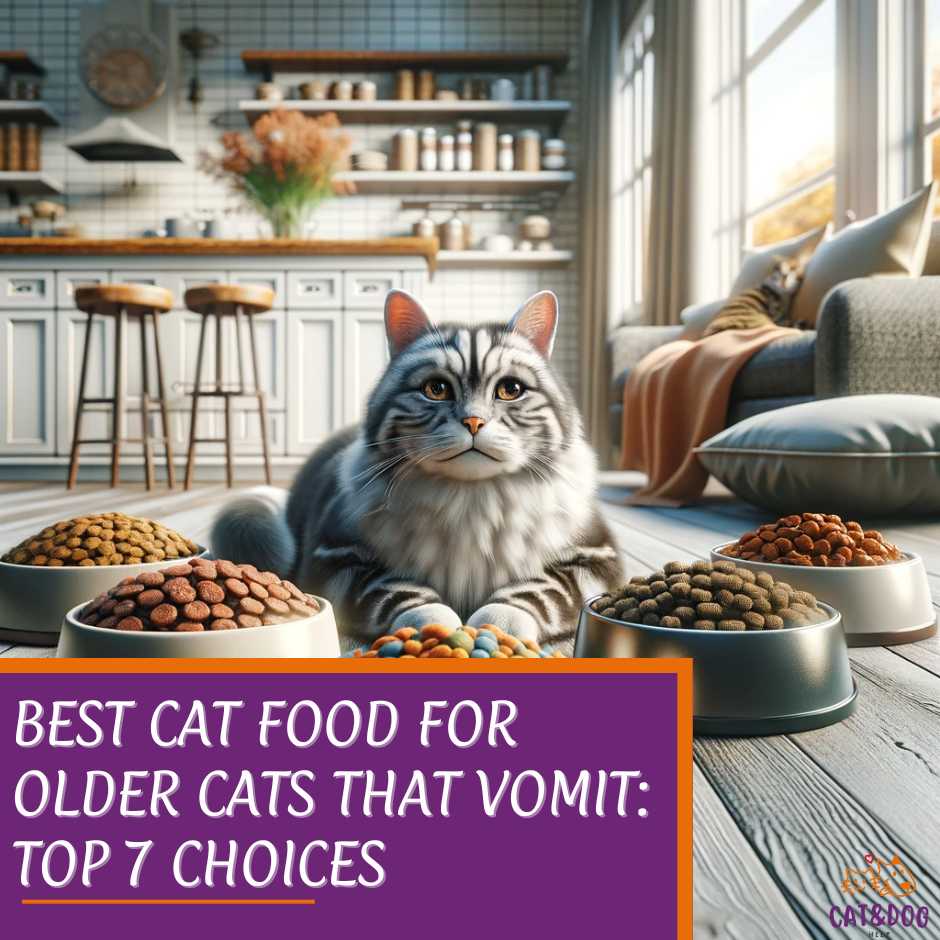When it comes to caring for older cats with health conditions, finding the right cat food is critical—especially if your feline friend has a sensitive stomach.
Older cats are often prone to vomiting issues due to decreased digestive capabilities or other health conditions that accompany aging.
The right diet, therefore, can make all the difference in their comfort and health.
The best cat food for older cats that vomit often features easily digestible ingredients, limited fillers, and added nutrients to support a senior cat’s overall well-being.
High-quality animal proteins, including whole grains, are essential for muscle maintenance, while fibers such as pumpkin can aid digestion.
It’s also essential for the food to be appetizing because let’s face it, cats can be quite the finicky eaters, especially when they don’t feel well.
When choosing cat food for your vomiting senior cat, pay close attention to the ingredient list. You want to avoid artificial additives and high-fat content, which may exacerbate vomiting.
Instead, look for foods with added supplements like prebiotics, probiotics, and enzymes that aid in digestion. Food texture can also play a role; some older cats may prefer wet food that’s easier to chew and digest.
Gradually transitioning your cat’s food diet can also help prevent digestive upset and vomiting.
Top 7 Best Cat Food for Older Cats That Vomit
Have you noticed your senior furball reacting poorly to their usual diet?
It’s not uncommon for older cats to have sensitive stomachs, which can lead to the unpleasant reality of frequent vomiting.
The search for the perfect cat food that is both nourishing and gentle on your cat’s digestive system, specifically for their cat’s tummy, can be daunting, but don’t fret!
We’ve scoured the market and dug into the nitty-gritty details to bring you a selection of the best cat foods formulated specifically for mature cats who struggle with this issue.
Each product not only aims to limit those messy incidents but also caters to the nutritional needs specific to their life stage, receiving positive reviews.
Ready to find a meal that’ll make both you and your kitty purr with satisfaction? Let’s get into our top picks!
#1 – Hill’s Senior Delight
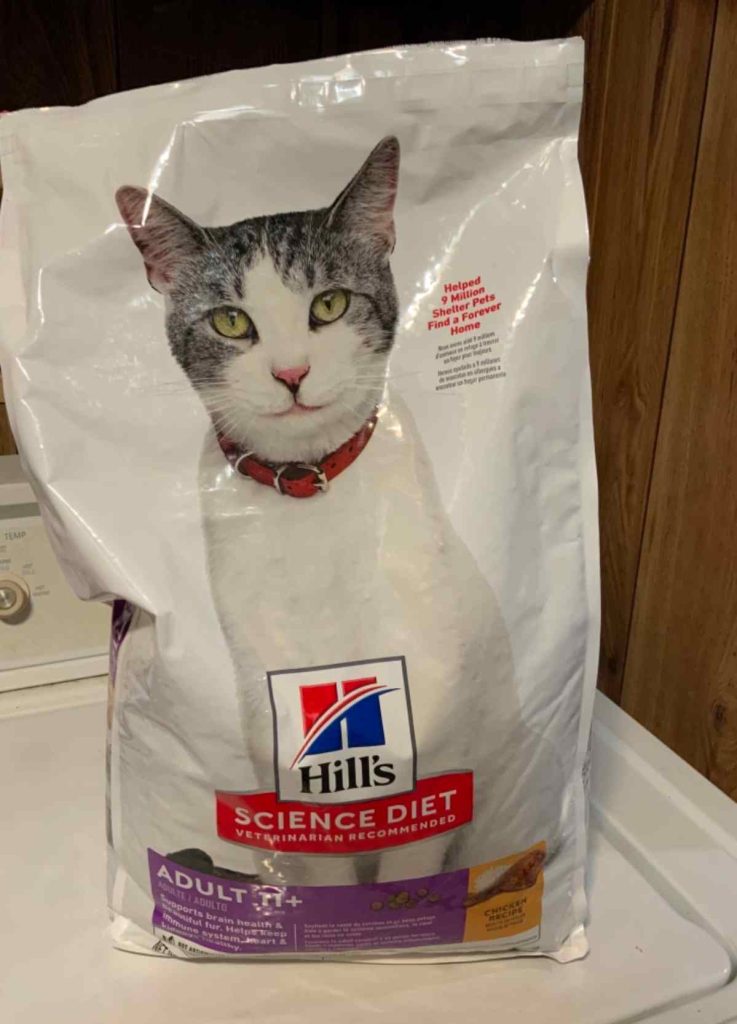
If your senior furball has a tender tummy and is picky about their kibble, Hill’s Senior Delight could be the game-changer you’re looking for.
Check Best PriceWhen your older cat starts grumbling about their usual meals, it might be time to introduce Hill’s Senior Delight to their diet.
I’ve watched my senior kitty, once troubled by occasional upsets, become way more enthusiastic come mealtime.
It’s like every kibble is a little nugget of joy for them – the days of post-dinner discomfort seem to be a tale of the past!
Upon switching to Hill’s, I noticed my cat’s energy perk up. Say goodbye to lazy afternoons; with Hill’s Senior Delight, it’s like my furball found the fountain of youth.
The balanced minerals in the food are a big plus too, especially for maintaining my kitty’s bladder and kidney health, which is super important at their age.
But remember, moderation is key!
Despite its great quality, overfeeding can lead to unwelcome weight gain, as some fur parents have learned the hard way including myself.
It’s also a little steeper in price, but for the difference it makes, I find it’s worth those extra pennies.
Plus, if your cat has a particularly sensitive stomach, keep an eye out; while the natural fibers work wonders for most, those with ultra-sensitive tummies might need something even more specialized.
#2 – Purina ONE Sensitive Systems
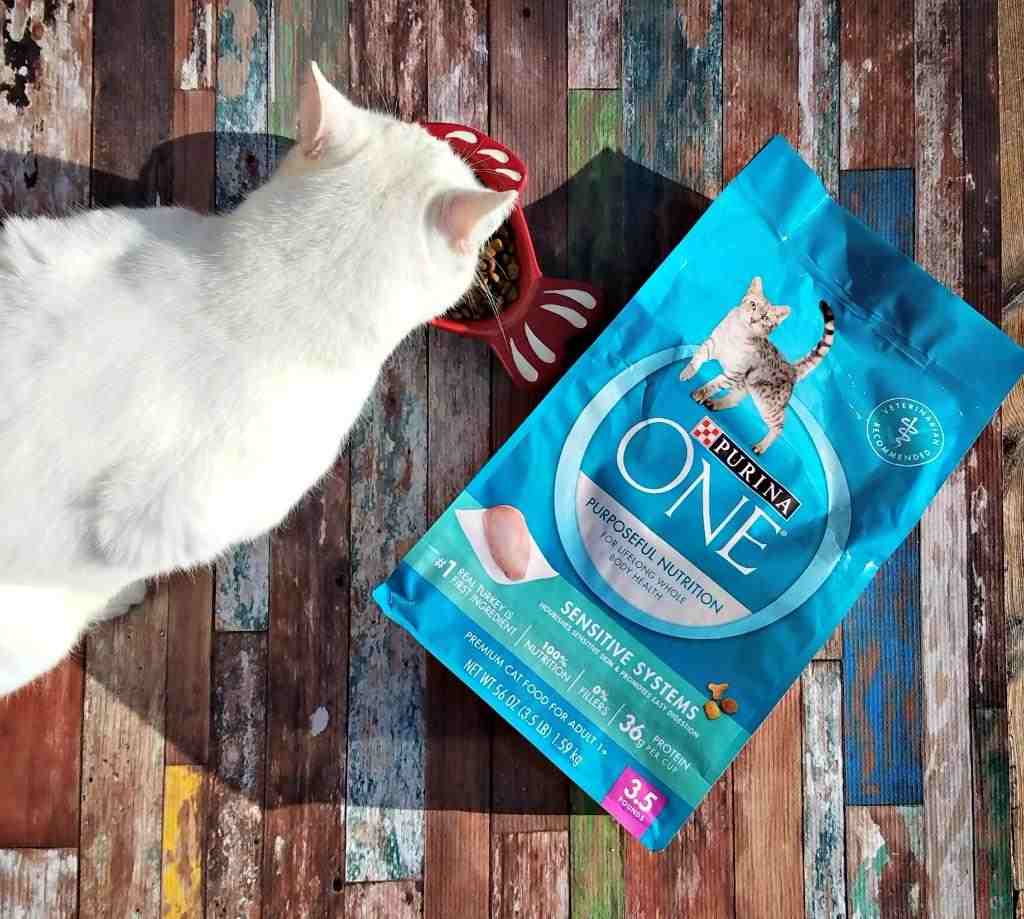
Your feline friend deserves a meal that’s both nourishing and enjoyable, especially if they’re prone to an upset stomach. Purina ONE Sensitive Systems might just be the answer to their needs.
Check Best PriceWhen you pour a bowl of Purina ONE Sensitive Systems, it’s like offering a gourmet feast tailored for your aging companion’s delicate palate.
The real turkey sings of quality, ensuring your cat’s muscles get the support they need to leap onto their favorite perch with ease.
Having seen the difference it makes, you can rest easy knowing those tender guts are in for a treat, not a trial.
The added prebiotic fiber seems to do the trick, and it’s heartwarming to see Mr. Whiskers coming back for seconds without any tummy upsets.
The magic in each bite doesn’t stop there: their chompers get a good workout as well, keeping those toothy grins healthy. But oh! The way they look at you when they crunch that kibble – pure bliss!
Some cats might indeed give you the cold shoulder when you first introduce them to this feast, but with a bit of patience, they’ll thank you.
I can’t deny the price tag might make you think twice, but isn’t the comfort of your four-legged friend worth that extra bit?
Besides, it’s not every day you come by a solution that brings back the joy of mealtime and peace of mind for you.
In short, you’ve found more than just a meal here – it’s a game changer for older cats with sensitive stomachs. Cheers to happier days and cleaner floors!
#3 – Blue Buffalo Tastefuls for Sensitive Tummies
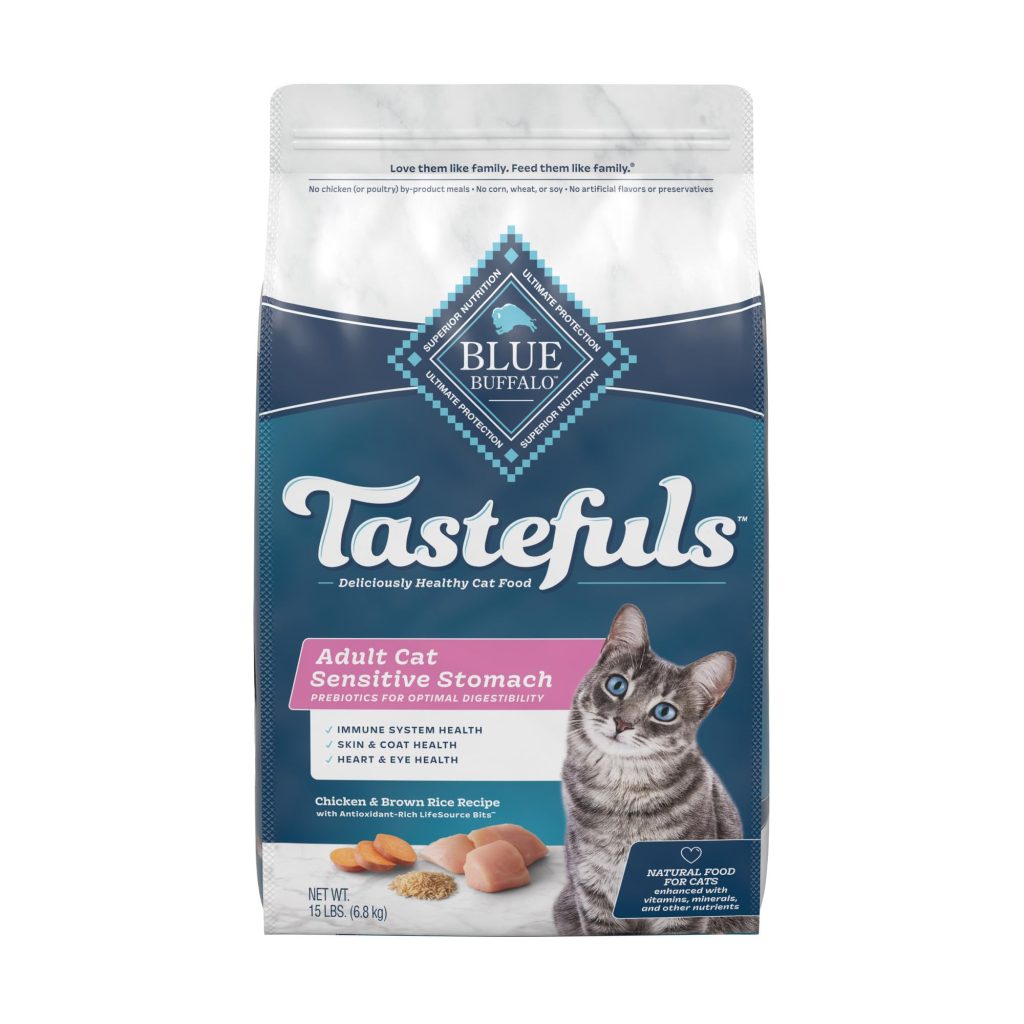
Your senior cat will likely adore Blue Buffalo Tastefuls for its gentle formula, potentially making those unpleasant vomit episodes a thing of the past.
Check Best PriceAfter recently switching my senior furball to Blue Buffalo Tastefuls, I’ve noticed a significant reduction in his upset stomach episodes. The specially tailored formula seems to suit his sensitive digestive system quite well.
The absence of poultry by-product meals and no artificial preservatives is something any cat parent can feel good about.
Observing my cat’s coat becoming glossier and his energy levels improving has been truly gratifying.
Despite the higher price point, the benefits I’ve seen in my cat’s health make Blue Buffalo Tastefuls a worthy investment.
However, not all cats may take to the taste immediately, but a gradual transition should help acclimatize picky eaters to this high-quality food.
#4 – Hill’s Science Diet Senior Cat Food
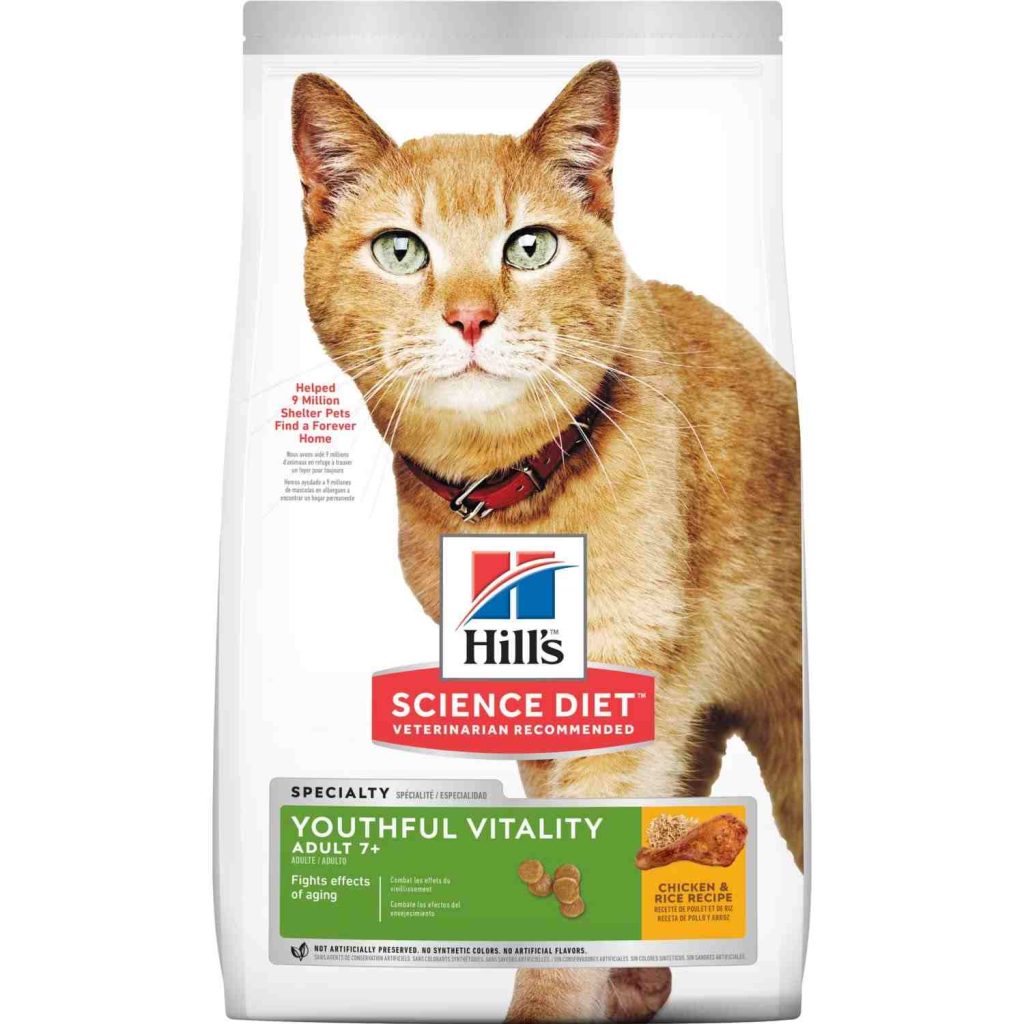
Your older cat might just leave an empty bowl and a purr of satisfaction with Hill’s Science Diet Senior Formula.
Check Best PriceEver noticed your older feline friend turning their nose up at dinner time? Say no more! With Hill’s Science Diet for seniors, you’re giving your fluffy companion a meal tailored to their golden years.
A blend of vitamin E, omega-3s, and omega-6s in this chow has left my senior tabby’s coat looking like she’s back in her prime!
Let’s chat about digestion. Is your purr ball a bit more sensitive than it used to be?
The natural fibers packed into this senior special are gentle on the stomach. In my experience, it’s made those unpleasant clean-up sessions a rare event.
But here’s the kicker, the balanced minerals are like kryptonite for bladder and kidney issues, which can be a game changer for your geriatric kitty’s wellbeing.
But take heed, my friend—portion control is paramount. Too much of this good thing, and you might be dealing with a chunky cat before you know it.
Remember, a healthy pet is a happy pet—and a happy pet makes a happy you!
If you want to see your aged feline thriving, consider making the switch to Hill’s Science Diet Senior Cat Food, which is specially formulated to meet the nutritional needs of older adult cats.
Just be sure to keep an eye on that serving size, and your old cat could be frolicking with the spryness of a much younger kitty.
#5 – Blue Wilderness Indoor Chicken
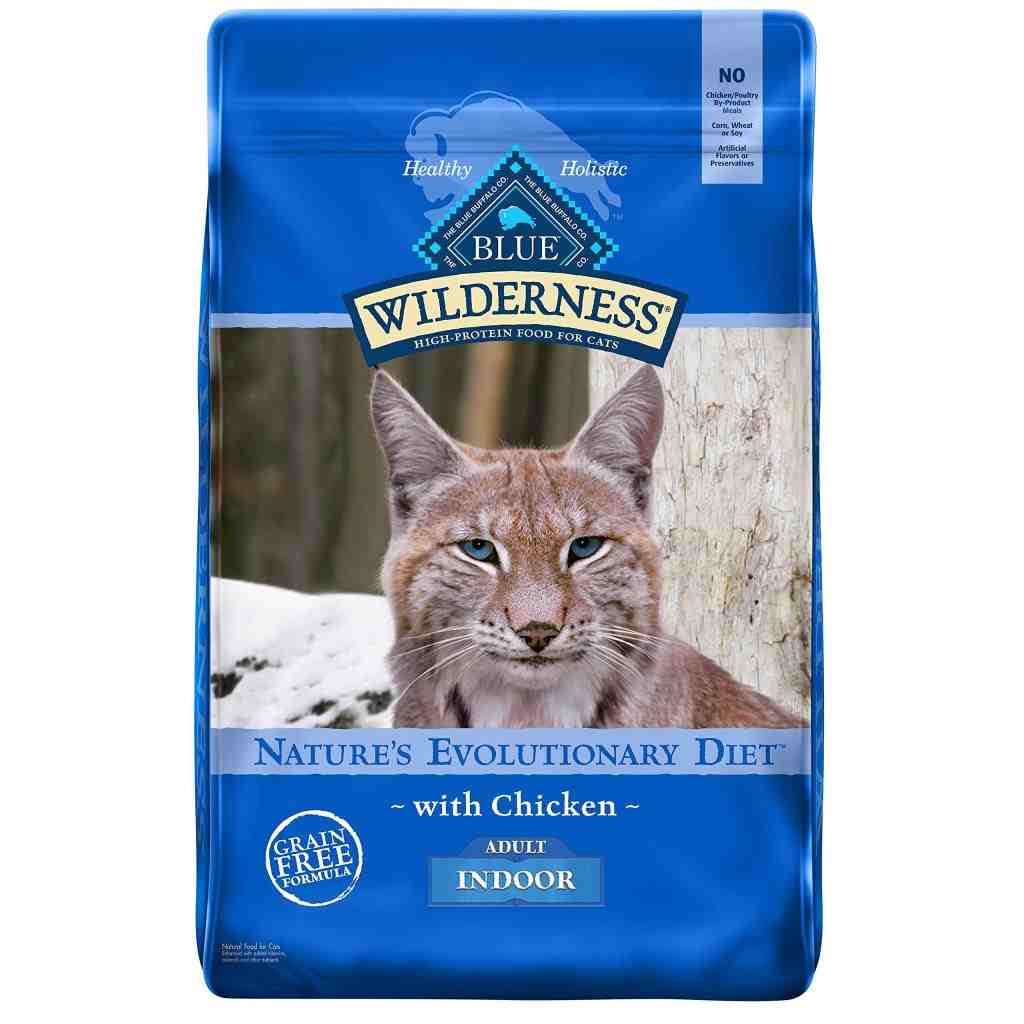
Your mature feline friend will likely adore the richness in flavor and the tender care put into Blue Wilderness Indoor Chicken.
Check Best PriceEver noticed your older cat becoming a bit of a barf baron in their golden years? It’s not exactly a royal title you’d want for your sweet furball, right?
Well, Blue Wilderness Indoor Chicken could just be the dinner-time peace treaty you’ve been looking for.
Let me tell you, as someone who’s witnessed the pangs of a sensitive kitty stomach, a food that doesn’t trigger the vomit reflex is worth its weight in gold.
With this mouth-watering high-protein meal, I watched my senior tabby transform. The puking episodes? Vanished.
His energy levels are something to purr about—it’s like he’s reliving his kitten days, minus the mischievous curtain climbing. And that coat of his?
Glossier than a freshly waxed sports car!
The only real snag is the wallet wince. Top-notch ingredients and feline health perks do come at a premium. But consider this: you might save on those vet bills in the long run.
Plus, wouldn’t you spend a tad more for the joy of a non-nauseous, ninja-esque kitty?
Switching to Blue Wilderness Indoor Chicken was like giving my cat the VIP pass to a happier belly and a lifeless queasy. And isn’t that what we all want for our whiskered companions?
#6 – Blue Buffalo Wilderness Cat Food
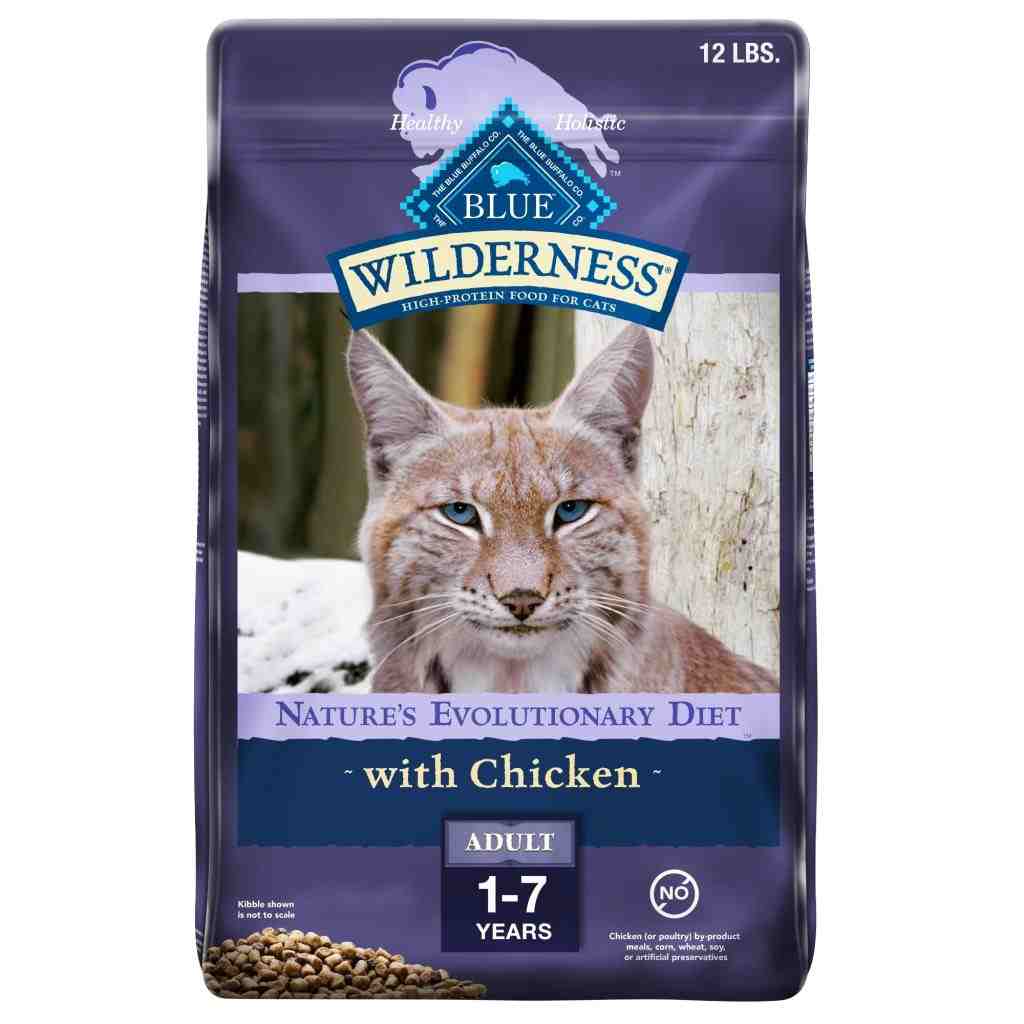
Eager to stop the upchucks and keep your senior feline thriving? This might just be your silver bullet.
Check Best PriceEver wondered how to silence the sound of your cat’s middle-of-the-night hairball serenade?
I recently introduced Blue Buffalo Wilderness Cat Food, including the Blue Buffalo Sensitive Stomach variety, to my senior tabby’s feeding routine, and let me tell you, it’s been a game-changer.
The grain-free formula seems to be gentle on her fickle stomach and digestive tract, and the pieces are just the right size for her to crunch through – no more gobbling down too quickly and then redecorating the carpet.
Have you noticed your older cat’s coat losing its shine?
This blend’s Omega-3 and Omega-6 fatty acids, as well as amino acids, have transformed my cat’s fur from dull to dazzle. Her coat now has a sheen that would make show cats envious.
And the high protein content? It’s like a fountain of youth; she’s got a spring in her step that’s reminiscent of her kitten days.
Navigating the world of cat food can make your head spin, but the Blue Buffalo Wilderness line with its natural ingredients – starring real chicken – provides a nourishing passport to digestive peace.
The absence of grains, corn, soy, and brown rice is especially clutch for cats that might react badly to such ingredients.
My moggy has become my mealtime shadow, eagerly awaiting the next serving. The sensitive stomach formula has FOS prebiotics to help support your cat’s digestive system and reduce vomiting.
These prebiotics also promote healthy nutrient absorption. Omega 3 and 6 fatty acids promote healthy skin and a shiny coat. And they can also help heal existing damage.
It’s a little heavier on the wallet, sure, but isn’t the lack of surprise stomach upsets worth it?
However, the robust, natural aroma – while divine to your cat – might have you zipping up the bag quicker than you can say “dinner time”.
And, let’s face it, every cat is an individual; while mine adores it, some cats might turn up their whiskers at the rich new menu.
Remember, even the most well-received food can be a no-go for some, so keep a keen eye on how your furball fares with a new diet.
Ready to give your pouchy pal a taste of the wild side with food that brings out their inner lynx?
Check out Blue Buffalo Wilderness Cat Food, including options for Maine Coon cats, and watch them prowl their domestic jungle with renewed vigor.
#7 – Hill’s Science Diet 7+
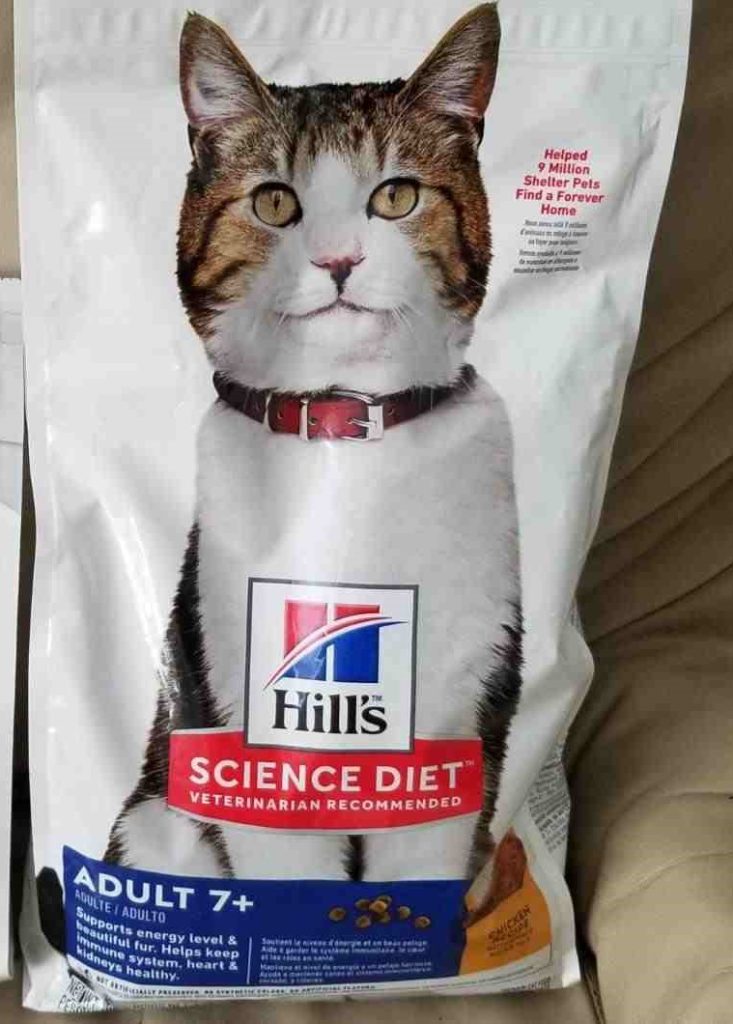
Give this feline favorite a try to keep your maturing cat both happy and nourished.
Check Best PriceEver noticed your older furball acting a bit queasy after mealtime? It’s not just you – and it’s not just them.
Aging cats need a specific blend of nutrients to keep them purring, and Hill’s Science Diet for Seniors nails this.
It’s reassuring to see them relish their meals without the aftermath, thanks to the easy-to-digest formula sourced from trusted locations around the United States.
Taking care of a senior cat requires a lot of TLC, and the right diet is a big part of that. I’ve been mixing up this Hill’s Science Diet recipe with their usual food for a smooth transition.
Interestingly, their energy seems to have taken a positive turn, and that’s saying something for old whiskers who usually love their nap times!
Shop for Hill’s Science Diet Adult Sensitive Stomach & Skin Chicken & Rice Recipe Dry Cat Food.
What’s impressive is the positive change in their coat – it’s gone from dull to dazzling, and even the vet couldn’t help but comment. But let’s keep it real; this stuff comes with a price tag that reflects its quality.
If you’re budget-conscious, this might make you think twice. That said, the lack of digestive drama makes it worth every penny.
It’s clear why this diet comes vet-recommended. Sure, it’s a small act to choose a kibble, but seeing the difference it makes in your aging cat’s life is truly the reward.
While it would be great to see more flavors to keep those finicky feline taste buds interested, it’s clear Hill’s Science has prioritized health over an extensive menu.
Comprehensive Nutritional Needs of Older Cats
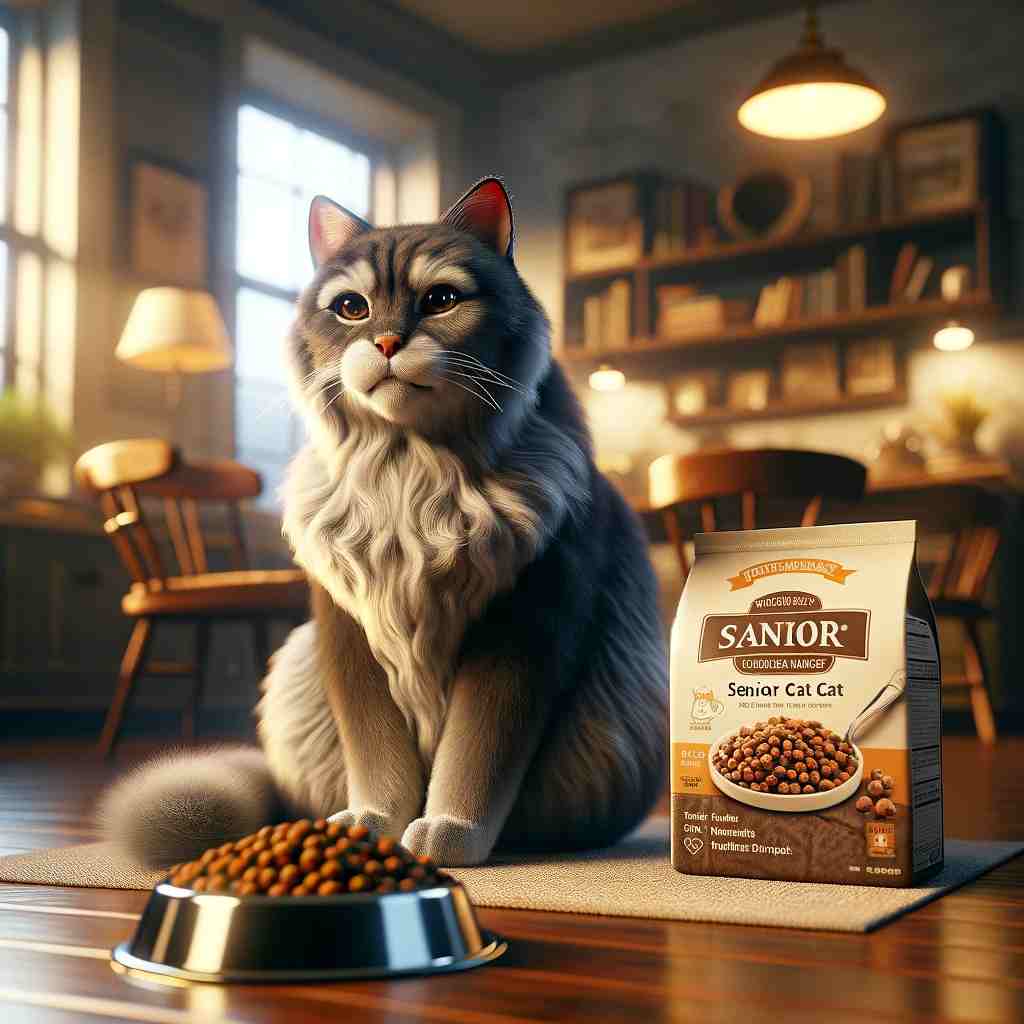
Are you wondering what’s essential in your older cat’s diet? Their needs change as they age, just like ours! Let’s break it down.
Essential Nutrients and Dietary Requirements
- Protein: Senior cats need high-quality protein to maintain muscle mass. Look for digestible sources like chicken or fish. (1)
- Fats: Essential fatty acids are critical for energy and supporting cell function. Omega-3s are particularly good for joint health. (2)
- Fiber: A moderate amount of soluble fiber can support gastrointestinal health and aid in digestion. (3)
Vitamins and minerals are key players too:
- Calcium and Phosphorus: These maintain strong bones. (4)
- Potassium: This is crucial for nerve and muscle function. (5)
- Vitamins E and C: These antioxidants fight off harmful free radicals. (6)
Managing Common Health Issues through Diet
Your older cat might face some common ailments, but a few dietary tweaks can help:
- Arthritis: Omega-3 fatty acids can help reduce inflammation and soothe sore joints. (7)
- Obesity: A well-balanced diet with controlled portions and low-calorie content can manage weight. (8)
- Dental Issues: Kibble designed for dental health can reduce plaque and tartar buildup.
Remember, every cat is unique! It’s a good idea to chat with your vet to tailor their diet to their specific needs.
Is your fur baby a bit picky or facing health issues? A vet might suggest a specialized diet to keep them purring. With the right nutrients and care, you can help your senior cat live a comfy and happy life!
Selecting the Right Cat Food

When your senior cat is prone to vomiting, it’s crucial to find a cat food that’s going to be gentle on their tummy, right?
You want to ensure they’re getting the nutrition they need without the added mess. Let’s talk ingredients and brands, and make this selection process a breeze for you.
Ingredients to Look for:
- High-quality protein: Choose foods with proteins like chicken or turkey at the top of the ingredient list.
- Omega fatty acids: These are vital for maintaining healthy skin and coat, common in ingredients like fish oil.
Ingredients to Avoid:
- Excessive carbohydrates: Cats have little nutritional need for carbs, and they can upset sensitive stomachs.
- Artificial additives: Preservatives, colors, and flavors may contribute to digestive issues, so best to sidestep these.
Comparison of Popular Brands:
- Brand A: Renowned for high-protein content and inclusion of omega fatty acids, often recommended by vets.
- Brand B: May contain more carbohydrates than ideal, but typically more affordable.
- Brand C: Noted for limited ingredient recipes, a good choice if you suspect food allergies.
Are you eyeing that ingredient list yet? Remember, every cat is as unique as their quirky ways of demanding attention, so a little patience and attention to these details go a long way.
Stick to these tips, and you’ll likely find something that keeps your purring pal both healthy and happy!
Feeding Strategies for Sensitive Stomachs
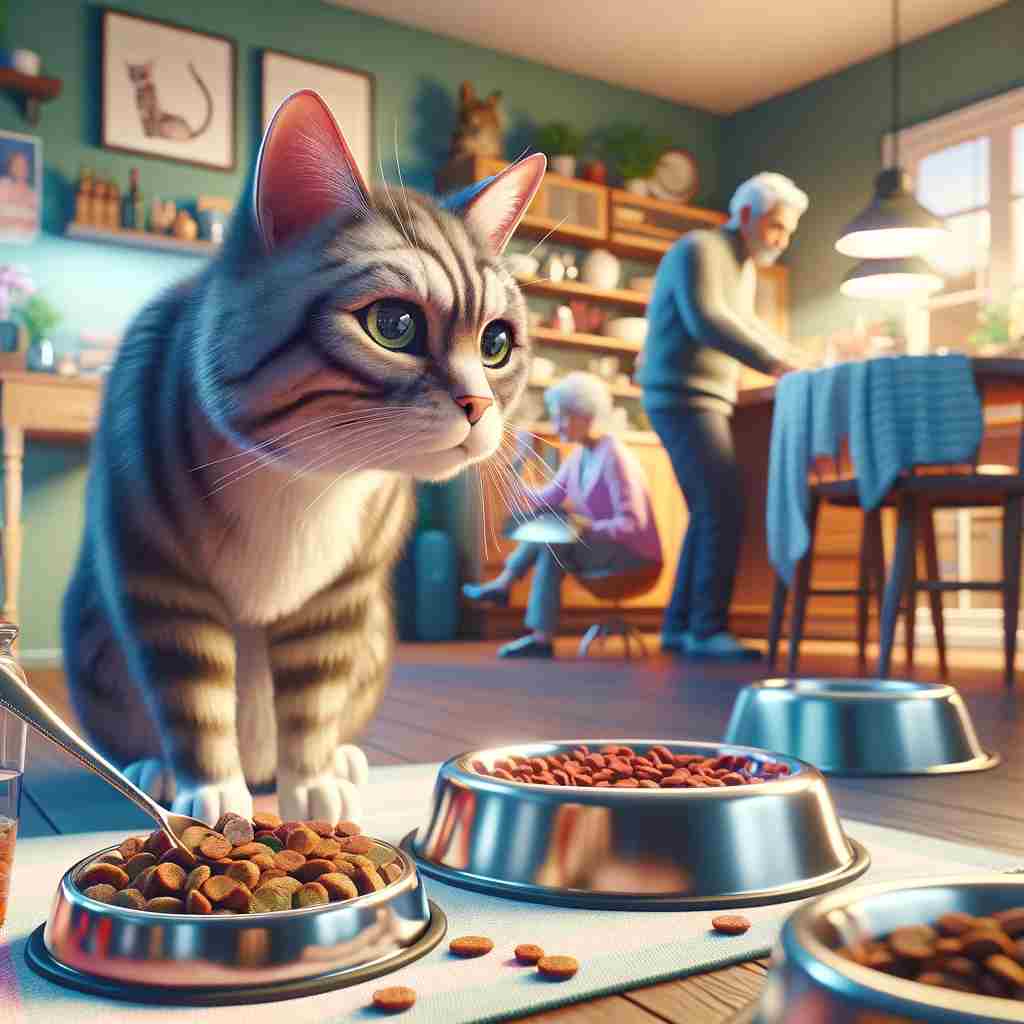
Ever had a finicky feline friend who can’t seem to keep their food down?
Tailoring your buddy’s diet to their tummy can make a world of difference. Let’s chat about making mealtime a breeze for your older cat with a sensitive stomach.
Portion Control and Meal Timing
- Keep it Small and Frequent: Start by adjusting the meal size. Instead of two large meals, how about serving several small meals throughout the day? This helps to ease the digestion process and could prevent unpleasant accidents.
- Slow and Steady: If your cat gulps food down as if it’s a race, consider a slow-feed bowl. This nifty dish encourages slower eating, which can ease digestion and reduce the risk of vomiting.
Transitioning to New Food
When it’s time to switch to a new grub, patience is key. Rapid changes can upset your cat’s stomach even more.
- Mix It Up Gradually: Gradually introduce the new fare by mixing it with the old nosh. Over 7-10 days, increase the portion of new food while decreasing the old, giving your cat’s digestive system time to adjust.
- Monitor and Adjust: Keep an eye out for any signs of tummy trouble during this change. If vomiting occurs, slow down the transition process. It’s all about listening to what your furry friend’s stomach can handle.
Remember, these tweaks can be small but mighty in keeping your older cat’s tummy as happy as they make you feel. Feed with love and a dash of strategy, and here’s to fewer messes and more purrs!
Expert Opinions and Veterinary Advice

Insights from Veterinarians and Nutritionists
Ever wonder what the pros say about keeping your senior cat’s tummy happy?
Here’s the scoop! “Senior cats often need foods that are easy to digest due to their slower metabolism and cat’s digestive system,” says Dr. Whiskers, a renowned feline nutritionist.
And hey, palatability is crucial – they have to like what they’re eating, right?
Additionally, during their senior and geriatric years, cats usually experience more health problems than they did in their younger years, so it’s important to keep a keen eye on your cat during this time.
- “Low-fat and high-fiber diets can reduce instances of vomiting,” notes Dr. Paws, a vet with 20 years under her belt. She also suggests probiotics to support a healthy gut flora.
- Hydration is key. Dr. Claw recommends wet food or adding water to dry food to prevent dehydration, a common issue that can lead to vomiting.
Latest Research and Studies
Curious about the science? Check this out:
- A 2023 study found that older cats showed fewer signs of gastrointestinal upset when fed a diet with moderate protein from easily digestible sources.
- Proteins like chicken, turkey, and rabbit are your friends here – they’re gentler on old kitty stomachs.
- Research in the Journal of Feline Medicine and Surgery shows that antioxidants and fatty acids, like those found in salmon oil, can help maintain health and reduce inflammation, which may contribute to a happier gut.
So, you’ve got some solid advice now. Choose cat foods that tick these boxes, and you’re on a good path. Just remember, your furry friend’s needs are unique, so what works for one cat might not work for another.
When in doubt, your vet can help guide you to the perfect choice for your purring companion.
Additional Care Tips
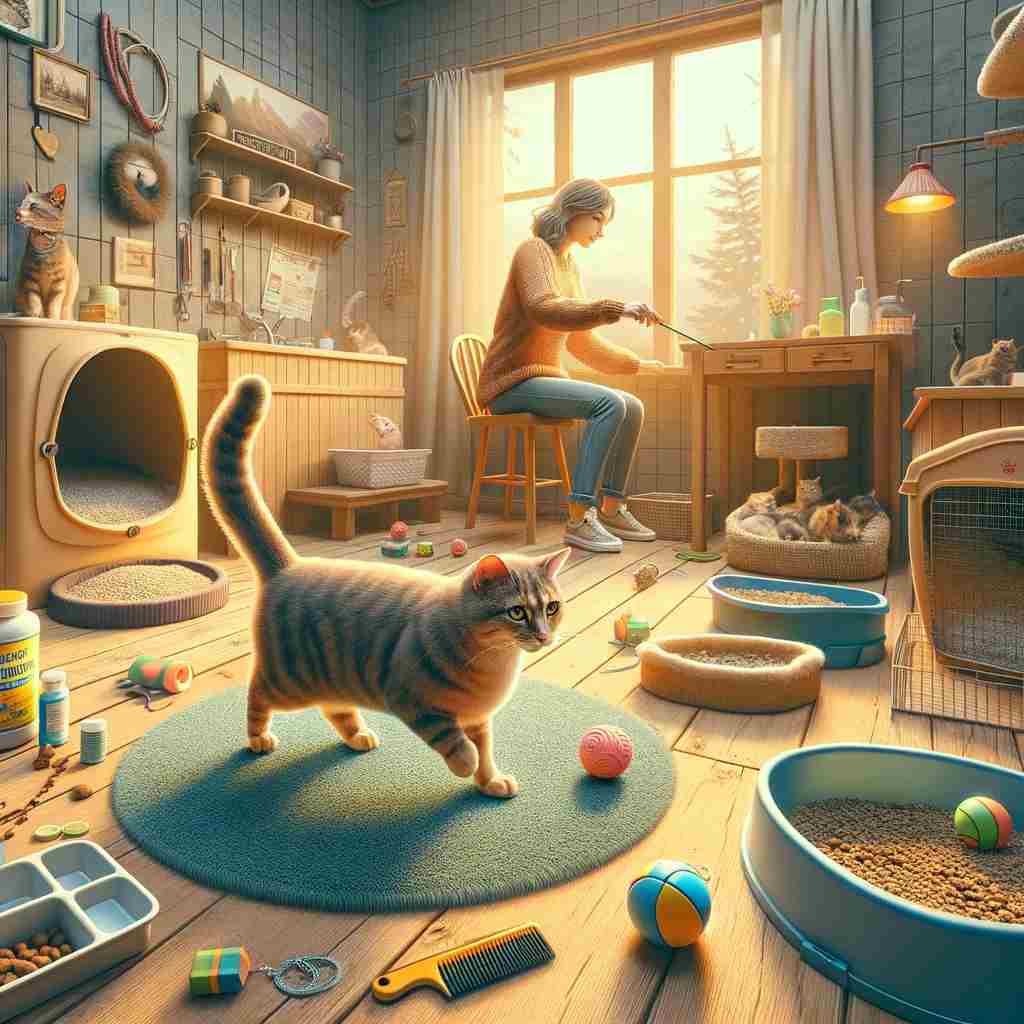
Hey there, fur-parents! Let’s ensure your senior kitty stays happy and healthy. When it comes to food, are you thinking beyond the bowl? Here’s the scoop on a couple of extras that can make a mealtime difference:
Hydration and Water Intake
- Is your cat getting enough water? Remember, they need to stay hydrated, especially if their diet is heavy on the kibble. Cats can be sneaky about sipping, but keeping fresh water bowls in various spots can encourage drinking. Did you know a cat fountain can be super enticing for your whiskered buddy? It’s like a mini waterfall at home!
Regular Health Check-Ups
- Got those vet visits penciled in your calendar? They’re non-negotiable! Routine check-ups are vital for catching any health hiccups early. Plus, your vet can help adjust diets and care as your cuddly companion ages. Consider it part of your “kitty maintenance” routine.
Balancing the diet and care of an older cat prone to vomiting might seem tricky, but with the right approach and a dash of love, you’ve got this!
Keep it simple, stay observant, and always, always spoil them with cuddles. Because at the end of the day, isn’t that what it’s all about?
Buying Guide
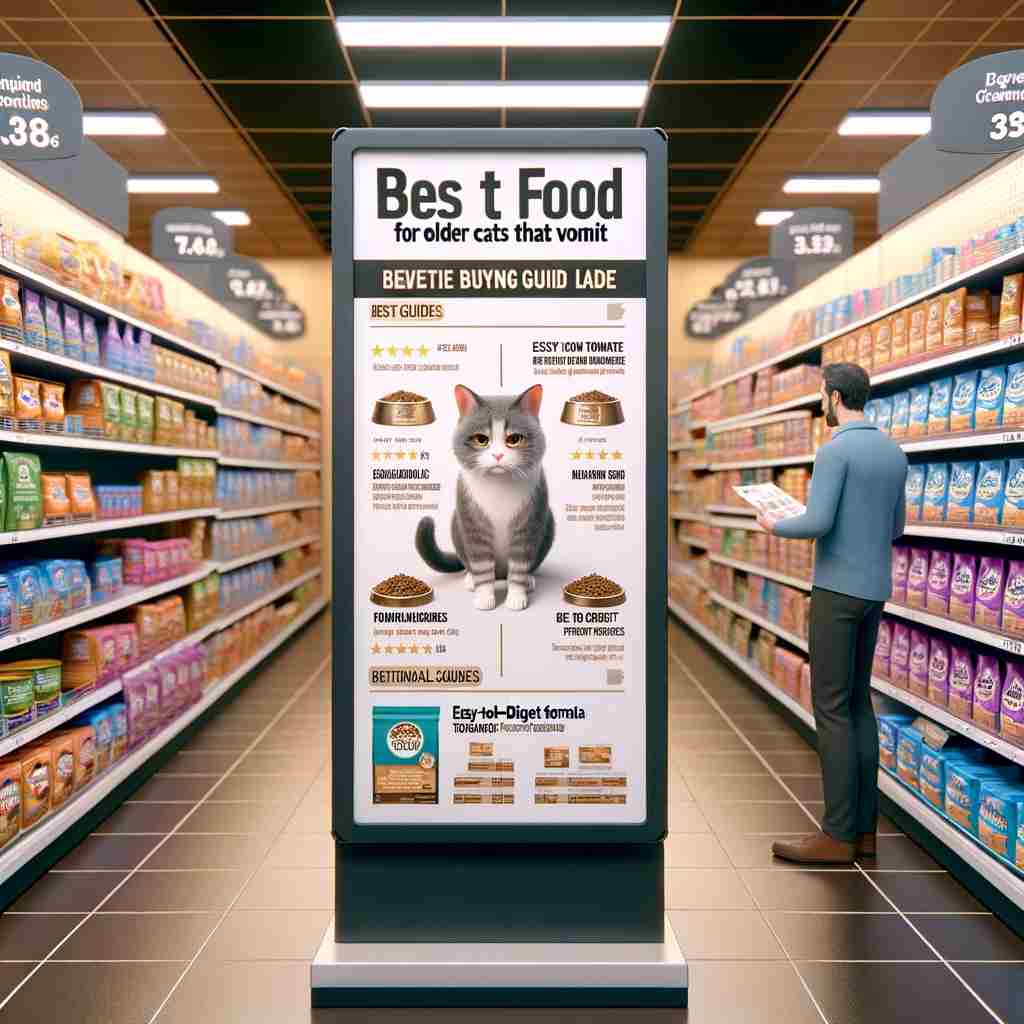
Nutritional Content
Hey, you’re on the hunt for something that’ll agree with your older cat’s tummy, right? Let’s talk about what to look for:
- Protein: It should be high-quality and easy to digest. Typically, look for food where protein comes from a single source.
- Fat: A moderate amount is essential, but too much can be hard on your cat’s system.
- Fiber: A bit of fiber can help, but too much can cause issues. Aim for a balance.
Specialized Ingredients
Check for ingredients that support digestion:
- Prebiotics and Probiotics: These are great for gut health.
- Easily Digestible Carbs: Simple carbs can be easier on the stomach.
Form and Texture
- Wet Food: It’s often more palatable and easier to eat.
- Pate: Can be smoother for sensitive stomachs, compared to chunks in gravy.
Palatability
It has to taste good, or your cat won’t touch it!
- Aromatic: Older cats might have a weaker sense of smell, so food needs to be enticing.
- Taste testing: Try a few different flavors to see what your cat prefers.
Age-Appropriate
Are you aware that senior cat food is a thing?
- Tailored Nutrients: Older cats have specific needs, like joint support and lower calorie content.
Avoid Irritants
Steer clear of known irritants:
- No artificial colors or flavors: These can upset sensitive stomachs.
- Grain-Free Options: If grains don’t sit well with your cat, look for grain-free recipes.
Here’s a quick reference table for you:
| Aspect to Consider | Why It’s Important | What to Look For |
| Protein Quality | Digestibility | Single source |
| Fat Content | Energy without strain | Moderate levels |
| Fiber | Digestive health | Balanced amount |
| Special Ingredients | Enhance digestion | Prebiotics, Probiotics |
| Form & Texture | Ease of eating | Wet, pate-style |
| Palatability | Must taste good | Aromatic, taste-tested |
| Age Appropriation | Specific needs of seniors | Joint support, low-calorie |
| Irritants | Prevent reactions | No artificial additives, potential for grain-free |
Remember, always introduce new food gradually to your cat’s diet to avoid any digestive upset. Happy shopping!
Quick Recap
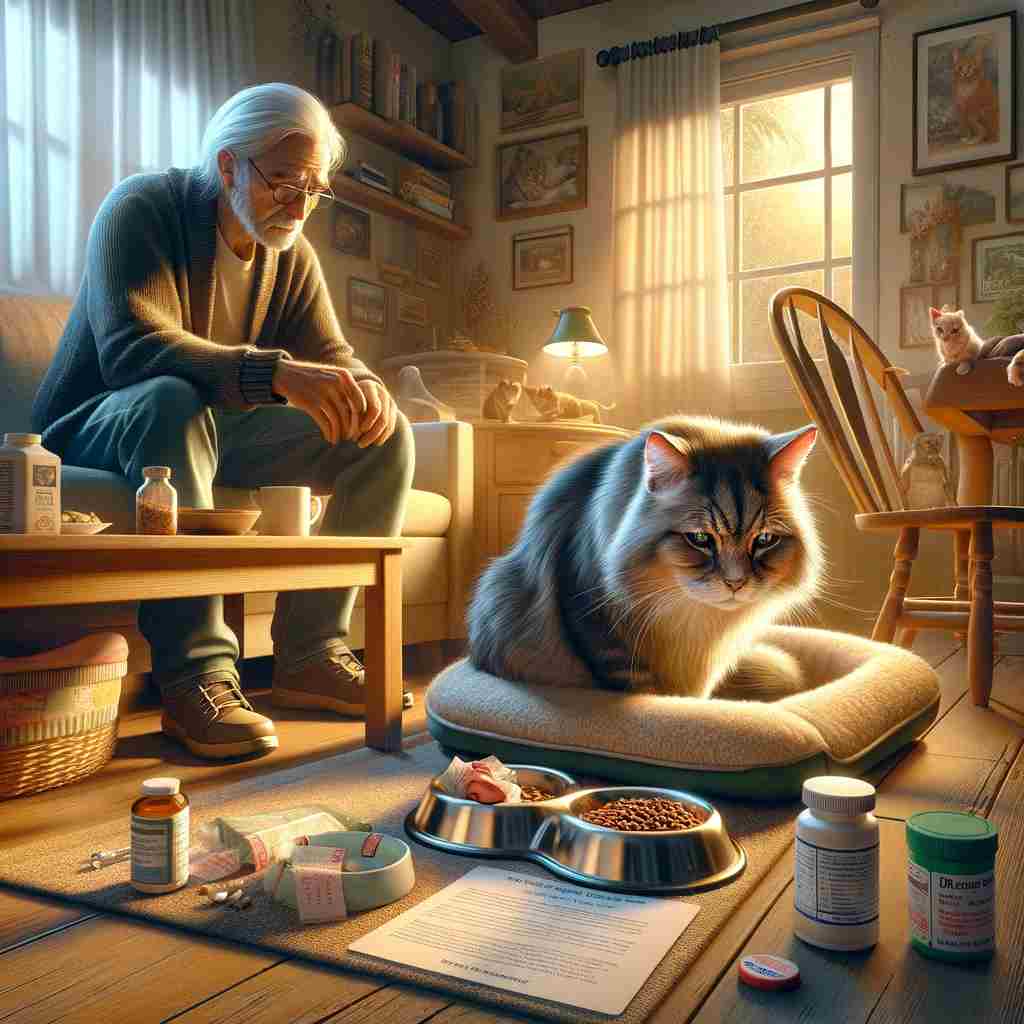
Having a senior cat that’s prone to vomiting can be worrying, right? You want the best for your furry friend! Here’s the lowdown on what to keep an eye out for:
Ingredients Matter: Cats with sensitive stomachs need easily digestible proteins. Look for foods labeled “limited ingredient” or those with a single protein source.
Wet or Dry? Wet food can be easier on the tummy and ensures your cat stays hydrated. Weigh your options, because some cats prefer the crunch of dry kibble.
- Moisture Content: Wet food > 75% moisture
- Dry Food: 5-10% moisture
Fiber is a Friend: A blend of soluble and insoluble fiber can aid digestion. A little pumpkin mixed in, maybe? Always fun and beneficial!
| Key Nutrient | Ideal Levels |
| Protein | Moderate, high quality |
| Fat | Low to moderate |
| Fiber | Moderate |
Small Portions, Big Difference: Smaller, more frequent meals can prevent overeating and reduce vomiting episodes.
Keep an Eye on Weight: Because being overweight isn’t just about the number on the scale; it affects your cat’s overall health, too!
Beware of Overfeeding: It’s not just the treats. Even the healthiest food can lead to digestive issues if overfed.
Remember, no magic number suits every cat. Your vet can guide the best diet plan. And don’t forget, sudden changes in diet can cause more harm than good, so any switch should be gradual.
Found the best match yet? Keep tracking your cat’s response to the new diet and make adjustments as needed. It’s all about finding the purr-fect balance for your aging companion!
Frequently Asked Questions
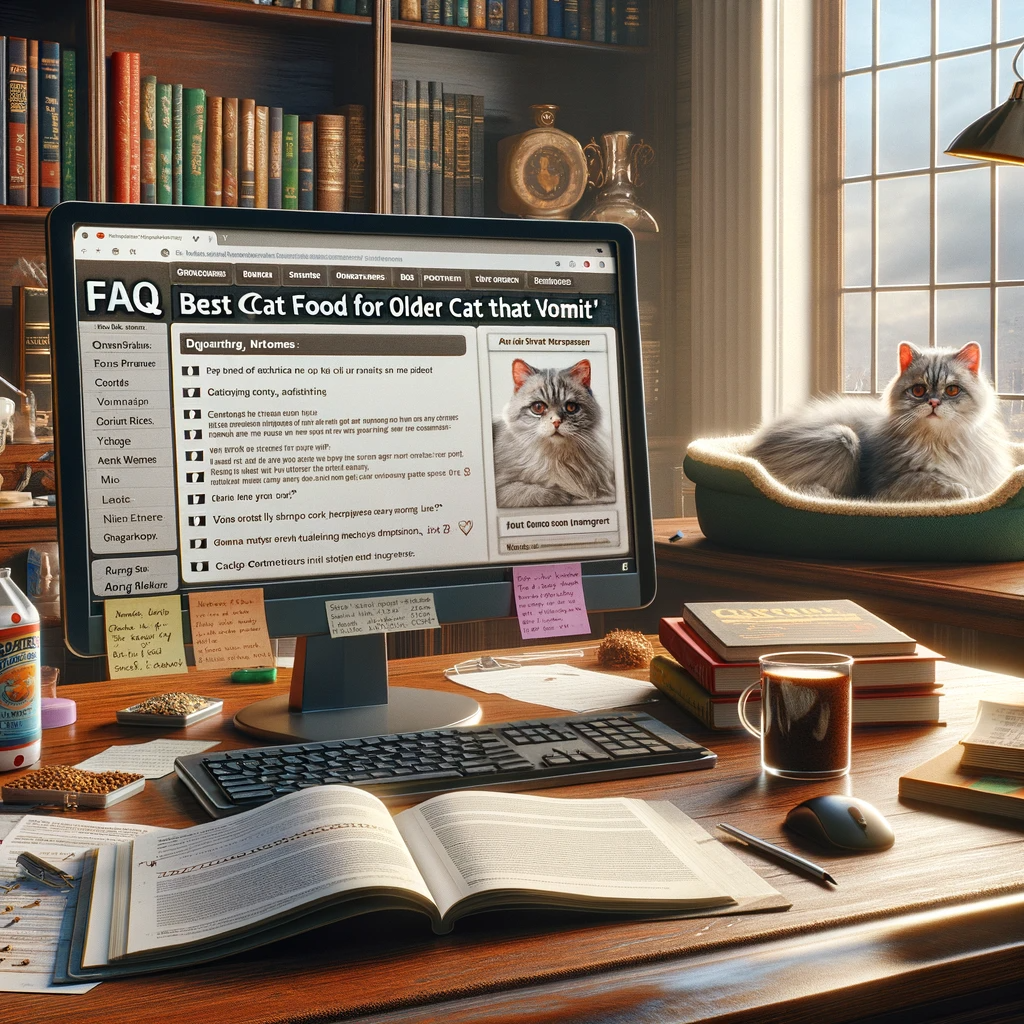
If your senior feline friend has a sensitive stomach, you’re probably looking for ways to minimize or prevent vomiting.
Here, we’ve compiled some specific questions and answers to guide you in choosing the right food for your cat’s needs to keep them happy and healthy.
What are the best types of food to feed an older cat with a sensitive stomach to reduce vomiting?
For your older cat’s sensitive stomach, lean toward easily digestible foods with high-quality protein sources such as chicken or turkey.
Look for limited-ingredient diets and foods that contain prebiotics and probiotics to support a healthy gut.
How can I adjust my senior cat’s diet to help prevent daily vomiting episodes?
Cut back on large meals and opt for smaller, more frequent feeding sessions. Also, ensure that the food has moderate fat levels and is high in moisture to aid digestion.
Introduce any dietary changes gradually over several days to avoid upset.
Are there specific wet cat foods that are recommended to avoid regurgitation in senior cats?
Yes, there are wet cat foods specifically formulated for sensitive stomachs.
These foods often contain a blend of fiber for digestive health and are void of common irritants like grain, gluten, and artificial additives.
Single-protein sources can also be beneficial.
What dry cat foods are known to help cats that throw up bile and undigested food?
Seek out dry cat foods that boast digestive enzymes, low-fat content, and probiotics.
These can help to soothe your cat’s stomach and ensure a more complete digestion of their food, reducing the chances of throwing up bile and undigested food.
Why might an older cat frequently vomit, and when is it a cause for concern?
Frequent vomiting in older cats could be due to a sensitive stomach, but it may also signal underlying health issues such as kidney disease or hyperthyroidism.
If vomiting is regular or accompanied by lethargy, weight loss, or other symptoms, consult your vet promptly.
Is it advisable to change an older cat’s diet if they vomit white foam, and what alternatives are beneficial?
If your cat is vomiting white foam, it could indicate gastritis or acid reflux. A diet with limited ingredients and an increase in dietary fiber may help.
Avoid rich foods and consider introducing a bland diet or a prescription food recommended by your veterinarian.
- Where to find the most trustworthy real money casinos - August 7, 2025
- Online Casinos That Approve PayPal: The Ultimate Overview - August 7, 2025

